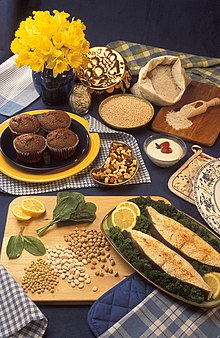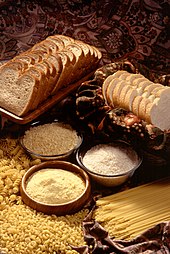
A | B | C | D | E | F | G | H | CH | I | J | K | L | M | N | O | P | Q | R | S | T | U | V | W | X | Y | Z | 0 | 1 | 2 | 3 | 4 | 5 | 6 | 7 | 8 | 9

Human nutrition deals with the provision of essential nutrients in food that are necessary to support human life and good health.[1] Poor nutrition is a chronic problem often linked to poverty, food security, or a poor understanding of nutritional requirements.[2] Malnutrition and its consequences are large contributors to deaths, physical deformities, and disabilities worldwide.[3] Good nutrition is necessary for children to grow physically and mentally, and for normal human biological development.[2]
Overview
The human body contains chemical compounds such as water, carbohydrates, amino acids (found in proteins), fatty acids (found in lipids), and nucleic acids (DNA and RNA). These compounds are composed of elements such as carbon, hydrogen, oxygen, nitrogen, and phosphorus. Any study done to determine nutritional status must take into account the state of the body before and after experiments, as well as the chemical composition of the whole diet and of all the materials excreted and eliminated from the body (including urine and feces).
Nutrients
The seven major classes of nutrients are carbohydrates, fats, fiber, minerals, proteins, vitamins, and water.[4] Nutrients can be grouped as either macronutrients or micronutrients (needed in small quantities). Carbohydrates, fats, and proteins are macronutrients, and provide energy.[4] Water and fiber are macronutrients, but do not provide energy. The micronutrients are minerals and vitamins.[4]
The macronutrients (excluding fiber and water) provide structural material (amino acids from which proteins are built, and lipids from which cell membranes and some signaling molecules are built), and energy. Some of the structural material can also be used to generate energy internally, and in either case it is measured in joules or kilocalories (often called "Calories" and written with a capital 'C' to distinguish them from little 'c' calories). Carbohydrates and proteins provide 17 kJ approximately (4 kcal) of energy per gram, while fats provide 37 kJ (9 kcal) per gram,[5] though the net energy from either depends on such factors as absorption and digestive effort, which vary substantially from instance to instance.
Vitamins, minerals, fiber,[6] and water do not provide energy, but are required for other reasons. A third class of dietary material, fiber (i.e., nondigestible material such as cellulose), seems also to be required, for both mechanical and biochemical reasons, though the exact reasons remain unclear. For all age groups, males on average need to consume higher amounts of macronutrients than females. In general, intakes increase with age until the second or third decade of life.[7]
Some nutrients can be stored – the fat-soluble vitamins – while others are required more or less continuously. Poor health can be caused by a lack of required nutrients, or for some vitamins and minerals, too much of a required nutrient. Essential nutrients cannot be synthesized by the body, and must be obtained from food.
Molecules of carbohydrates and fats consist of carbon, hydrogen, and oxygen atoms. Carbohydrates range from simple monosaccharides (glucose, fructose, galactose) to complex polysaccharides (starch). Fats are triglycerides, made of assorted fatty acid monomers bound to a glycerol backbone. Some fatty acids, but not all, are essential in the diet: they cannot be synthesized in the body. Protein molecules contain nitrogen atoms in addition to carbon, oxygen, and hydrogen.[8] The fundamental components of protein are nitrogen-containing amino acids, some of which are essential in the sense that humans cannot make them internally. Some of the amino acids are convertible (with the expenditure of energy) to glucose and can be used for energy production just as ordinary glucose, in a process known as gluconeogenesis. By breaking down existing protein, some glucose can be produced internally; the remaining amino acids are discarded, primarily as urea in urine. This occurs naturally when atrophy takes place, or during periods of starvation.[citation needed]
The list of nutrients that people are known to require is, in the words of Marion Nestle, "almost certainly incomplete".[9]
Carbohydrates

Carbohydrates may be classified as monosaccharides, disaccharides or polysaccharides depending on the number of monomer (sugar) units they contain. They are a diverse group of substances, with a range of chemical, physical and physiological properties.[10] They make up a large part of foods such as rice, noodles, bread, and other grain-based products,[11][12] but they are not an essential nutrient, meaning a human does not need to eat carbohydrates.[13]
Monosaccharides contain one sugar unit, disaccharides two, and polysaccharides three or more. Monosaccharides include glucose, fructose and galactose.[14] Disaccharides include sucrose, lactose, and maltose; purified sucrose, for instance, is used as table sugar.[15] Polysaccharides, which include starch and glycogen, are often referred to as 'complex' carbohydrates because they are typically long multiple-branched chains of sugar units.
Traditionally, simple carbohydrates were believed to be absorbed quickly, and therefore raise blood-glucose levels more rapidly than complex carbohydrates. This is inaccurate.[16][17][18][19] Some simple carbohydrates (e.g., fructose) follow different metabolic pathways (e.g., fructolysis) that result in only a partial catabolism to glucose, while, in essence, many complex carbohydrates may be digested at the same rate as simple carbohydrates.[20] The World Health Organization recommends that added sugars should represent no more than 10% of total energy intake.[21]
The most common plant carbohydrate nutrient – starch – varies in its absorption. Starches have been classified as rapidly digestible starch, slowly digestible starch and resistant starch.[22] Starches in plants are resistant to digestion (resistant starch), but cooking the starch in the presence of water can break down the starch granule and releases the glucose chains, making them more easily digestible by human digestive enzymes.[23] Historically, food was less processed and starches were contained within the food matrix, making them less digestible.[24] Modern food processing has shifted carbohydrate consumption from less digestible and resistant starch to much more rapidly digestible starch.[25][26] For instance, the resistant starch content of a traditional African diet was 38 grams/day.[27] The resistant starch consumption from countries with high starch intakes has been estimated to be 30-40 grams/day.[28] In contrast, the average consumption of resistant starch in the United States was estimated to be 4.9 grams/day (range 2.8-7.9 grams of resistant starch/day).[29]
Fat
This section needs more reliable medical references for verification or relies too heavily on primary sources. (April 2019) |  |
A molecule of dietary fat typically consists of several fatty acids (containing long chains of carbon and hydrogen atoms), bonded to a glycerol. They are typically found as triglycerides (three fatty acids attached to one glycerol backbone). Fats may be classified as saturated or unsaturated depending on the chemical structure of the fatty acids involved. Saturated fats have all of the carbon atoms in their fatty acid chains bonded to hydrogen atoms, whereas unsaturated fats have some of these carbon atoms double-bonded, so their molecules have relatively fewer hydrogen atoms than a saturated fatty acid of the same length. Unsaturated fats may be further classified as monounsaturated (one double-bond) or polyunsaturated (many double-bonds). Furthermore, depending on the location of the double-bond in the fatty acid chain, unsaturated fatty acids are classified as omega-3 or omega-6 fatty acids. Trans fats are a type of unsaturated fat with trans-isomer bonds; these are rare in nature and in foods from natural sources; they are typically created in an industrial process called (partial) hydrogenation. There are nine kilocalories in each gram of fat. Fatty acids such as conjugated linoleic acid, catalpic acid, eleostearic acid and punicic acid, in addition to providing energy, represent potent immune modulatory molecules.
Saturated fats (typically from animal sources) have been a staple in many world cultures for millennia. Unsaturated fats (e. g., vegetable oil) are considered healthier, while trans fats are to be avoided. Saturated and some trans fats are typically solid at room temperature (such as butter or lard), while unsaturated fats are typically liquids (such as olive oil or flaxseed oil). Trans fats are very rare in nature, and have been shown to be highly detrimental to human health, but have properties useful in the food processing industry, such as rancidity resistance.[30]
Essential fatty acids
This section needs more reliable medical references for verification or relies too heavily on primary sources. (February 2020) |  |
Most fatty acids are non-essential, meaning the body can produce them as needed, generally from other fatty acids and always by expending energy to do so. However, in humans, at least two fatty acids are essential and must be included in the diet. An appropriate balance of essential fatty acids—omega-3 and omega-6 fatty acids—seems also important for health, although definitive experimental demonstration has been elusive. Both of these "omega" long-chain polyunsaturated fatty acids are substrates for a class of eicosanoids known as prostaglandins, which have roles throughout the human body.
The omega-3 eicosapentaenoic acid (EPA), which can be made in the human body from the omega-3 essential fatty acid alpha-linolenic acid (ALA), or taken in through marine food sources, serves as a building block for series 3 prostaglandins (e.g., weakly inflammatory PGE3). The omega-6 dihomo-gamma-linolenic acid (DGLA) serves as a building block for series 1 prostaglandins (e.g. anti-inflammatory PGE1), whereas arachidonic acid (AA) serves as a building block for series 2 prostaglandins (e.g. pro-inflammatory PGE 2). Both DGLA and AA can be made from the omega-6 linoleic acid (LA) in the human body, or can be taken in directly through food. An appropriately balanced intake of omega-3 and omega-6 partly determines the relative production of different prostaglandins. In industrialized societies, people typically consume large amounts of processed vegetable oils, which have reduced amounts of the essential fatty acids along with too much of omega-6 fatty acids relative to omega-3 fatty acids.
The conversion rate of omega-6 DGLA to AA largely determines the production of the prostaglandins PGE1 and PGE2. Omega-3 EPA prevents AA from being released from membranes, thereby skewing prostaglandin balance away from pro-inflammatory PGE2 (made from AA) toward anti-inflammatory PGE1 (made from DGLA). The conversion (desaturation) of DGLA to AA is controlled by the enzyme delta-5-desaturase, which in turn is controlled by hormones such as insulin (up-regulation) and glucagon (down-regulation).
Zdroj:https://en.wikipedia.org?pojem=Human_nutritionText je dostupný za podmienok Creative Commons Attribution/Share-Alike License 3.0 Unported; prípadne za ďalších podmienok. Podrobnejšie informácie nájdete na stránke Podmienky použitia.
Antropológia
Aplikované vedy
Bibliometria
Dejiny vedy
Encyklopédie
Filozofia vedy
Forenzné vedy
Humanitné vedy
Knižničná veda
Kryogenika
Kryptológia
Kulturológia
Literárna veda
Medzidisciplinárne oblasti
Metódy kvantitatívnej analýzy
Metavedy
Metodika
Text je dostupný za podmienok Creative
Commons Attribution/Share-Alike License 3.0 Unported; prípadne za ďalších
podmienok.
Podrobnejšie informácie nájdete na stránke Podmienky
použitia.
www.astronomia.sk | www.biologia.sk | www.botanika.sk | www.dejiny.sk | www.economy.sk | www.elektrotechnika.sk | www.estetika.sk | www.farmakologia.sk | www.filozofia.sk | Fyzika | www.futurologia.sk | www.genetika.sk | www.chemia.sk | www.lingvistika.sk | www.politologia.sk | www.psychologia.sk | www.sexuologia.sk | www.sociologia.sk | www.veda.sk I www.zoologia.sk
